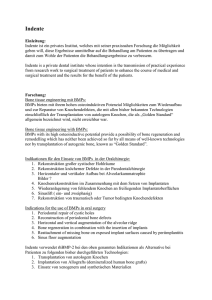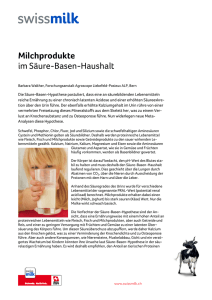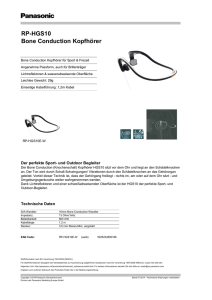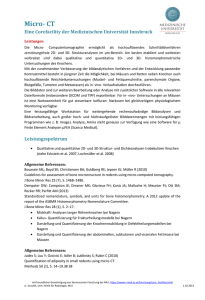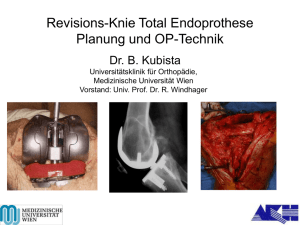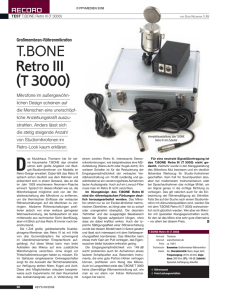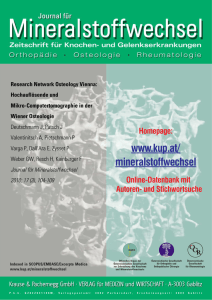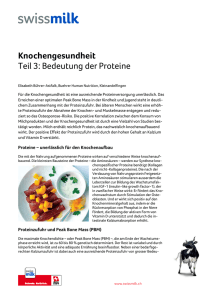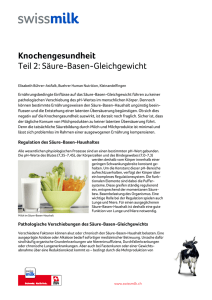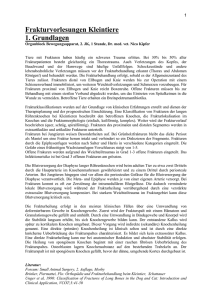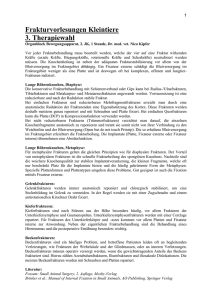PowerPoint-Präsentation
Werbung
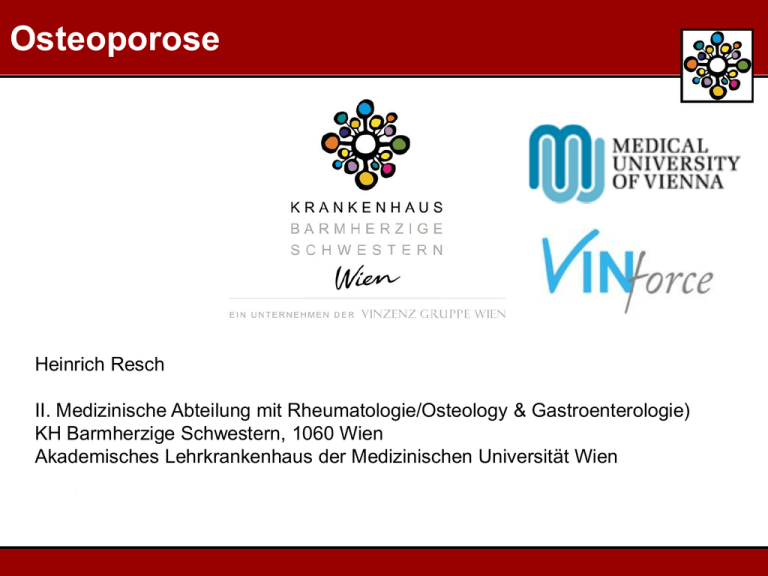
Osteoporose Heinrich Resch II. Medizinische Abteilung mit Rheumatologie/Osteology & Gastroenterologie) KH Barmherzige Schwestern, 1060 Wien Akademisches Lehrkrankenhaus der Medizinischen Universität Wien Hüftfrakturen Österreich Alter > 50á) 14.000 12.000 Frauen Männer 10.000 8.000 6.000 4.000 2.000 0 Quelle: Statistik Austria ; ICD-9, ICD-10 Korrekturfaktor Mehrfachregistrierung: ~0.97 Dimai HP et al, 2009 unpublished data Definition of Osteoporosis A skeletal disorder characterized by… Normal • Excessive osteoclast-mediated bone resorption • Compromised bone strength • Increased risk of fracture at all skeletal sites “Osteoporosis is one of the most common and debilitating chronic diseases, and a global healthcare problem.” International Osteoporosis Foundation “Osteoporosis has financial, physical, and psychosocial consequences, all of which significantly affect the individual, the family, and the community.” NIH Consensus Statement Boyle WJ, et al. Nature. 2003;423:337-342. NIH Consensus Development Panel. JAMA. 2001;285:785-795. Images:Y. Jiang. Osteoporosis & Arthritis Lab, University of Michigan. Osteoporosis Skeletal Form and Function • • The skeleton is a dynamic organ comprised of over 200 discrete bones with mechanical, protective, and metabolic functions Composed of two types of bone: • Cortical bone: Outer dense shell (~ 80% of total skeletal mass) • Trabecular bone: Network of connecting plates inside the cortical shell (~ 20% of total skeletal mass) Dempster DW. Primer on the Metabolic Bone Diseases and Disorders of Mineral Metabolism. 6th ed. 2006:7-11 Cortical Bone • • • Dense outer shell of compact bone; defines bone shape 80% of skeletal mass Essential functions • • • • Provides biomechanical strength Attachment site for tendon and muscle Protection against excess trauma Turnover rate of 2–3% per year Dempster DW. Primer on the Metabolic Bone Diseases and Disorders of Mineral Metabolism. 6th ed. 2006:7-11. Trabecular Bone • • • A sponge-like network of delicate plates of bone known as trabeculae 20% of skeletal mass Essential functions • • • Mineral metabolism Strength and elasticity Higher turnover rate compared to cortical bone Dempster DW. Primer on the Metabolic Bone Diseases and Disorders of Mineral Metabolism. 6th ed. 2006:7-11. Standardisierte Laboruntersuchungen großes internes Labor: • Elektrolyte inkl. Ca, Ph • Nierenparameter • Leberparameter • Alkalische Phosphatase • Blutbild Knochenstoffwechselparameter im Serum • PTH • S-CTX • P1NP • S-OC • 25(OH)Vit D ← ← ← ← ← Steuerhormon Abbaumarker - Osteoklasten Anbaumarker - Osteoblasten Anbaumarker - Osteoblasten Mineralisierung Die Geschichte mit den schweren Knochen……. Was wiegen die Knochen…. BMD g/cm2 Die Geschichte mit den schweren Knochen…. Falsche Messwerte Verkalkung der Aorta Skoliose Wirbelkörpereinbrüche degenerative Veränderungen Adipositas Prothesen Frakturschwelle unter Tscore -2.5 T-score femoral neck -2,5 -2,3 -2,1 -1,9 -1,7 -1,5 -1,3 -1,1 -0,9 -0,7 -0,5 -0,3 -0,1 0,2 0,5 100 90 80 70 60 50 40 30 20 10 0 0,9 % patients % vertebral fractures vs. T-score, cumulated Fracture Risk Assessment II Klinische dichotomisierte Risikofaktoren [BMI = 25] Alter prävalente Fragilitätsfrakturen Positive Familienanamnese einer Hüft-FX Glucocorticoide Rheumatoide Arthritis andere Gründe sekundärer Osteoporose Tägliche Alkoholmenge ≥ 3 Einheiten/d (1 E ~ 8-10g) Kanis JA et al. Osteoporosis Int 2008;19(4):385-397 Fracture Risk Assessment III Kanis JA et al. Osteoporosis Int 2008;19(4):385-397 FRAX Beispiel Kanis JA et al. Osteoporosis Int 2008;19(4):385-397 FRAX Beispiel Kanis JA et al. Osteoporosis Int 2008;19(4):385-397 Die 4 Substanzgruppen 1-ANTIRESORPTIV BISPHOSPHONATE Etidronat Alendronat Risedronat Ibandronat Zoledronat RALOXIFEN CALCITONIN 3-DUAL ACTING Sr RANELAT (DABA) 2-KNOCHENANABOL NaF MFP TERIPARATIDE Die 4 Substanzgruppen 1-ANTIRESORPTIV BISPHOSPHONATE Etidronat Alendronat Risedronat Ibandronat Zoledronat RALOXIFEN CALCITONIN 3-DUAL ACTING Sr RANELAT (DABA) 2-KNOCHENANABOL NaF MFP TERIPARATIDE 4-BIOLOGIKA-AK RANKL AK Denosumab KATHEPSIN K AG SCL AK Nachweis der Wirksamkeit einer Osteoporosetherapie: Information lt. österr. Nachweis der Wirksamkeit einer Osteoporosetherapie: Fachinformation Information lt. österr. Fachinformation Intervention Alendronat1 Ibandronat2 vertebrale Fraktur non-vertebrale Fraktur - HüftFraktur - Risedronat3 Zoledronat4 Calcitonin5 - - Raloxifen6 Strontiumranelat7 - Teriparatid (1-34)8 rhPTH (1-84)9 - - 1 FI Fosamax einmal wöchentlich 70mg, Stand Juni 2007. 2 FI Bonviva 3mg 3ml-Injektionslösung in einer Fertigspritze, Stand März 2006. 3 FI Actonel einmal wöchentlich 35mg, Stand August 2007. 4 FI Aclasta, Stand Oktober 2007. 5 FI Calcitonin „Novartis“ 100 I.E.-Nasalspray, Stand September 2005. 6 FI Evista 60mg-Filmtabletten, Stand März 2007. 7 FI Protelos 2g-Granulat zur Herstellung einer Suspension zum Einnehmen, Stand Februar 2007. 8 FI Forsteo 20 Mikrogramm/80 Mikroliter, Injektionslösung in einem vorgefüllten Injektor, Stand September 2005. 9 FI Preotact 100 Mikrogramm-Pulver und Injektionslösung zur Herstellung einer Injektionslösung, Stand April 2006. Therapiekomfort •Täglich •Wöchentlich •3-monatlich •1xjährlich •Tablette •Pulver •i.v.Injektion Metaanalyse zum Hüftfrakturrisiko mit unterschiedlichen Vitamin D Dosen Therapie der Wahl – SERMs? Cave Thrombose KLINIK: Unspez Kreuzschmerz DEXA lumbal T-score: -2.6 hip -1.48 Keine Frakturen Gesund/ genetisches Risiko Gewebsspezifische WirkungWirkung Gewebsspezifische O N Basische Seitenkette O Benzothiophen HO OH S ER Agonistische Effekte (Knochen, Fettstoffwechsel) • Erhöhung der BMD (Bone Mineral Density), somit Risikoreduktion von vertebralen Frakturen • Senkt Gesamt- und LDLCholesterin Antagonistische Effekte (Uterus, Brust) ER = Östrogen Rezeptor Invasives Mammacarcinom (Rezeptorstatus) Fahrleitner-Pammer A Journal für Mineralstoffwechsel 2007; 14 (1): 39-44 M.B. 73a PMO – Bisphosphonate - Cave Verträglichkeit KLINIK: Akuter Kreuzschmerz Periphere Frakturen St.p.Totalexst./ genetisches Risiko DXA: Niedrige Knochendichte Reflux? Welches Bisphosphonat?/ Wie lange? • Oral • Originalsubstanz/Generika Unverträglichkeit- mangelnde Wirkung • Parenteral • Ibandronat 3 Monate • Zoledronat 12 Monate • Dauer • 3-5-..15 Jahre • Folgetherapie – Drug Holiday Ibandronate: Nonvertebral fracture for higher versus lower ibandronate doses Fig. 1 Kaplan-Meier plot of time to nonvertebral fracture for higher versus lower ibandronate doses OI 2008 Zoledronsäure reduziert das 3-Jahres-Risiko morphometrischer vertebraler Frakturen (Stratum I) um 70% Plazebo ZOL 5 mg 70%* % Patienten mit neuer vertebraler Fraktur 15 (62%, 76%) 71%* (62%, 78%) 10 60%* (43%, 72%) 5 10.9% (310/2853) 7.7% (220/2853) 3.7% 3.3% (106/2853) 1.5% 2.2% (92/2822) (63/2822) (42/2822) 0 0–1 0–2 Jahre *P < .0001, relative Risikoreduktion vs. Plazebo (95% Konfidenzintervall) Black DM, et al. N Engl J Med. 2007;356:1809-1822. 0–3 Zoledronsäure reduziert das kumulative 3-Jahres-Risiko klinischer Frakturen (Hüfte, klinische Vertebralfx, non-vertebrale Fx) kumulative Häufigkeit (%) neuer klinischer Frakturen über 3 Jahre Placebo ZOL 5 mg 25%‡ (13%, 36%) 15 10,7% (388/3861) 10 41%* 77%† (17%, 58%) 5 2,5% (88/3861) (63%, 86%) 8,0% (292/3875) 2,6% 1,4% (52/3875) (84/3861) 0,5% (19/3875) 0 Hüftfrakturen Werte über den Balken sind kumulierte Ereignisraten über 3 Jahre gemäß Kaplan-Meier-Schätzung. *P = 0,0024; †P < 0,0001; ‡P = 0,0002; relative Risikoreduktion gegenüber Placebo §Hüftfrakturen wurden aus der Analyse der non-vertebralen Frakturen nicht ausgeschlossen. Black DM, et al. N Engl J Med. 2007;356:1809-1822. klinische Vertebralfrakturen non-vertebrale Frakturen A.P.78a BP Langzeit Therapie unabhängige Logistik cave Darm, Thrombose KLINIK: Chronischer Kreuzschmerz Periphere Frakturen Obstpation/ genetisches Risiko Venensituation DXA: Niedrige Knochendichte Long-term Treatment Effect of Strontium Ranelate (SOTI and TROPOS, follow-up 5 years) Reginster et al., Calcif Tissue Int 2007, 80: S47 PTH (TPTD,rhPTH) Intermittierend appliziert • • • • Proliferation der Präosteoblasten Anregung der Osteoblastenaktivität Hemmung des Osteoblastenabbaus Insgesamt Steigerung des Knochenumbaus (auch Osteoklasten werden, wenn auch etwas verzögert, angeregt) mehr Osteoblasten = osteoanabole (knochenaufbauende) Wirkung Vergleich TPTD mit rhPTH(1-84) TPTD20 Followed with Antiresorptive Treatment Lumbar Spine BMD 18 16 Percent change in BMD 14 12 AR < 6 months and at least 2yrs (n = 65) AR > 6 mos and at least 18 mos (n = 34) No OP drug use (n=144) 10 8 6 4 2 0 Endpoint Visit 1 Visit 2 Visit 3 (+6 months) (+18 months) (+30 months) Lindsay, Scheele et al. Endo Soc 2002. Eli Lilly and Company AKS07 BMD unter Teriparatide vs Alendronate bei GIO Saag et al, NEJM (2007) 357:2028-2039 Effects of Prior Antiresorptive Therapy on the Bone Mineral Density Response to Teriparatide Treatment S. Boonen et al. J Clin. Endocrinol Metab. 2007; epub Regulation des Knochenstoffwechsels durch Steuerpeptide OPG/Denosumab Stammzelle RANKL RANK Pre-Fusion OC Wachstumsfaktoren Hormone, Zytokine X vielkerniger OC X RANKL aktivierter OC Osteoblast Properties of Denosumab • • • • Fully human monoclonal antibody IgG2 immunoglobulin isotype High specificity for RANK Ligand No detectable binding to TNFα, TNFβ, TRAIL, or CD40L • No neutralizing antibodies detected in clinical trials to date • Effects on bone resorption appear reversible • High affinity for human RANK Ligand TNF = tumor necrosis factor; TRAIL = TNFα-related apoptosis-inducing Ligand. Bekker PJ, et al. J Bone Miner Res. 2004;19:1059-1066. Data on file, Amgen. Elliott R, et al. Osteoporos Int. 2007;18:S54. Abstract P149. McClung MR, et al. New Engl J Med. 2006;354:821-31. The FREEDOM Trial Fracture Efficacy Evaluation in Patients with Osteoporosis with Densosumab Over 6 Months Österreichische Zentren: 7808/100 Patienten Universitätsklinik Graz KH Hietzing KH Barmherzige Brüder Menox Klimax KH Speising KH Barmherzige Schwestern, Wien Jährliche Reduktion des vertebralen Fraktur Risikos 78% p < 0,0001 Placebo Denosumab 3,5 Crude incidence (%) 3 2,5 3,1% 65% p < 0,0001 3,1% 61% p < 0,0001 2,2% 2 1,5 1,1% 0,9% 0,7% 1 0,5 0 Year 1 Year 2 Year 3 Hüftfrakturen Cumulative Incidence (%) Placebo Denosumab 1,2% 40% p = 0,036 95% CI (3 to 63%) 0,7% 0 6 12 18 Study Month 24 30 36
